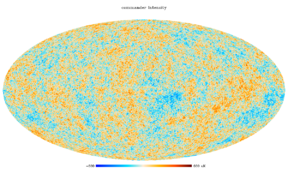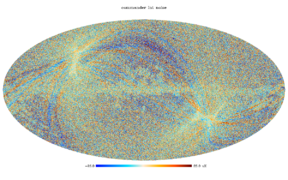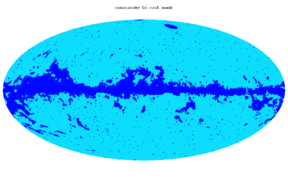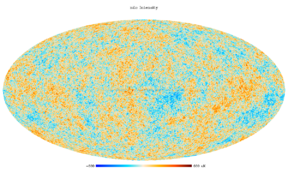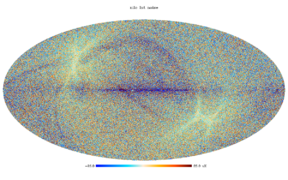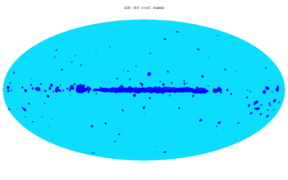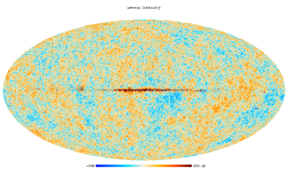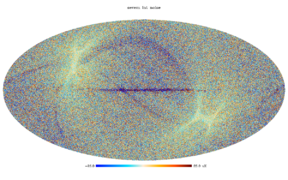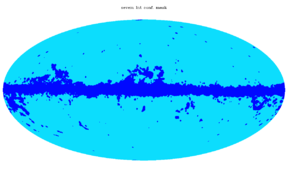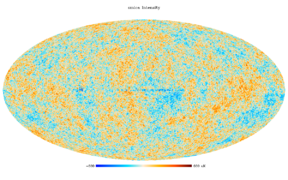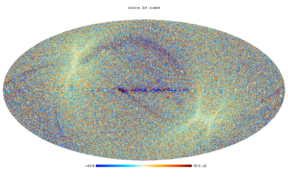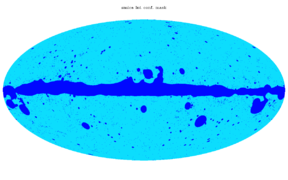CMB and astrophysical component maps
Contents
Overview[edit]
This section describes the maps of astrophysical components produced from the Planck data. These products are derived from some or all of the nine frequency channel maps described above using different techniques and, in some cases, using other constraints from external data sets. Here we give a brief description of the product and how it is obtained, followed by a description of the FITS file containing the data and associated information. All the details can be found in Planck-2015-A09[1] and Planck-2015-A10[2].
CMB maps[edit]
CMB maps have been produced by the COMMANDER, NILC, SEVEM, and SMICA pipelines, which are described in the CMB and foreground separation section and also in Appendices A-D of Planck-2015-A09[1] and references therein.. For each pipeline we provide:
- Full-mission CMB intensity map, confidence mask and beam transfer function.
- Full-mission high-pass filtered CMB polarisation map,
- A confidence mask.
- A beam transfer function.
In addition, and for characterisation purposes, there are six other sets of maps from three data splits: first/second half-ring, odd/even years and first/second half-mission. And for each of these data splits we provide half-sum and half-difference maps. The half-difference maps can be used to provide an approximate noise estimate for the full mission, but they should be used with caution. Each split has caveats in this regard: there are noise correlations between the half-ring maps, and missing pixels in the other splits. The Intensity maps are provided at Nside = 2048, at 5 arcmin resolution, while the Polarisation ones are provided at Nside = 1024 at 10 arcmin resolution. All maps are in units of Kcmb.
These maps can be found in the files
- COM_CMB_IQU-{pipeline}-field-{Int/Pol}_Nside_R2.00.fits.
The Int files have two extensions, for the Intensity maps and the beam transfer function, the Pol files have three extensions, for Q and U maps, and for the beam transfer function. For a complete description of the data structure, see the below; the content of the first extensions is illustrated and commented in the table below.
The gallery below shows the Intensity, noise from half-mission, half-difference, and confidence mask for the four pipelines, in the order SMICA, SEVEM, NILC and COMMANDER, from top to bottom. The Intensity maps scale is [–500.+500] μK, and the noise are between [–25,+25] μK. We do not show the Q and U maps since they have no significant visible structure to contemplate.
Product description[edit]
COMMANDER[edit]
- Principle
- COMMANDER is a Planck software code implementing pixel based Bayesian parametric component separation. Each astrophysical signal component is modelled in terms of a small number of free parameters per pixel, typically in terms of an amplitude at a given reference frequency and a small set of spectral parameters, and these are fitted to the data with an MCMC Gibbs sampling algorithm. Instrumental parameters, including calibration, bandpass corrections, monopole and dipoles, are fitted jointly with the astrophysical components. A new feature in the Planck 2015 analysis is that the astrophysical model is derived from a combination of Planck, WMAP and a 408 MHz (Haslam et al. 1982) survey, providing sufficient frequency support to resolve the low-frequency components into synchrotron, free-free and spinning dust. For full details, see Planck-2015-A10[2].
- Resolution (effective beam)
- The Commander sky maps have different angular resolutions depending on data products:
- The components of the full astrophysical sky model derived from the complete data combination (Planck, WMAP, 408 MHz) have a 1 degree FWHM resolution, and are pixelized at Nside=256. The corresponding CMB map defines the input map for the low-l Planck 2015 temperature likelihood.
- The Commander CMB temperature map derived from Planck-only observations have an angular resolution of ~5 arcmin and is pixelized at Nside=2048. This map is produced by harmonic space hybridiziation, in which independent solutions derived at 40 arcmin (using 30-857 GHz data), 7.5 arcmin (using 143-857 GHz data), and 5 arcmin (using 217-857 GHz data) are coadded into a single map.
- The Commander CMB polarization map has an angular resolution of 10 arcmin and is pixelized at Nside=1024. As for the temperature case, this map is produced by harmonic space hybridiziation, in which independent solutions derived at 40 arcmin (using 30-353 GHz data) and 10 arcmin (using 100-353 GHz data) are coadded into a single map.
- Confidence mask
- The Commander confidence masks are produced by thresholding the chi-square map characterizing the global fits, combined with direct CO amplitude thresholding to eliminate known leakage effects. In addition, we exclude the 9-year WMAP point source mask in the temperature mask. For full details, see Sections 5 and 6 in Planck-2015-A10[2]. A total of 81% of the sky is admitted for high-resolution temperature analysis, and 83% for polarization analysis. For low-resolution temperature analysis, for which the additional WMAP and 408 MHz observations improve foreground constraints, a total of 93% of the sky is admitted.
NILC[edit]
- Principle
- The Needlet-ILC (hereafter NILC) CMB map is constructed both in total intensity as well as polarization, Q and U Stokes parameters. For total intensity, all Planck frequency channels are included. For polarization, all polarization sensitive frequency channels are included, from 30 to 353 GHz. The solution, for T, Q and U is obtained by applying the Internal Linear Combination (ILC) technique in needlet space, that is, with combination weights which are allowed to vary over the sky and over the whole multipole range.
- Resolution (effective beam)
- The spectral analysis, and estimation of the NILC coefficients, is performed up to a maximum . The effective beam is equivalent of a Gaussian circular beam with FWHM=5 arcminutes.
- Confidence mask
- The same procedure is followed by SMICA and NILC for producing confidence masks, though with different parametrizations. A low resolution smoothed version of the NILC map, noise subtracted, is thresholded to 73.5 squared micro-K for T, and 6,75 squared micro-K for Q and U.
SEVEM[edit]
- Principle
- The aim of SEVEM is to produce clean CMB maps at one or several frequencies by using a procedure based on template fitting in real space. The templates are internal, i.e., they are constructed from Planck data, avoiding the need for external data sets, which usually complicates the analyses and may introduce inconsistencies. In the cleaning process, no assumptions about the foregrounds or noise levels are needed, rendering the technique very robust. The single frequency clean maps are then combined to obtain the final CMB map.
- Resolution
- For intensity the clean CMB map is constructed up to a maximum at Nside=2048 and at the standard resolution of 5 arcminutes (Gaussian beam).
- For polarization the clean CMB map is produced at Nside=1024 with a resolution of 10 arcminutes (Gaussian beam) and a maximum .
- Confidence masks
- The confidence masks cover the most contaminated regions of the sky, leaving approximately 85 per cent of useful sky for intensity and 80 per cent for polarization.
SMICA[edit]
- Principle
- SMICA produces CMBs map by linearly combining all Planck input channels with multipole-dependent weights. It includes multipoles up to . Temperature and polarization maps are produced independently.
- Resolution (effective beam)
- The SMICA intensity map has an effective beam window function of 5 arc-minutes which is truncated at and is not deconvolved from the pixel window function. Thus the delivered beam window function is the product of a Gaussian beam at 5 arcminutes and the pixel window function for Nside=2048.
- The SMICA Q and U maps are obtained similarly but are produced at Nside=1024 with an effective beam of 10 arc-minutes (to be multiplied by the pixel window function, as for the intensity map).
- Confidence mask
- A confidence mask is provided which excludes some parts of the Galactic plane, some very bright areas and the masked point sources. This mask provides a qualitative (and subjective) indication of the cleanliness of a pixel. See section below detailing the production process.
Production process[edit]
COMMANDER[edit]
- Pre-processing
- All sky maps are first convolved to a common resolution that is larger than the largest beam of any frequency channel. For the combined Planck, WMAP and 408 MHz temperature analysis, the common resolution is 1 degree FWHM; for the Planck-only all-frequency analysis it is 40 arcmin FWHM; and for the intermediate-resolution analysis it is 7.5 arcmin; while for the full-resolution analysis, we assume all frequencies between 217 and 857 GHz have a common resolution, and no additional convolution is performed. For polarization, only two smoothing scales are employed, 40 and 10 arcmin, respectively. The instrumental noise rms maps are convolved correspondingly, properly accouting for their matrix-like nature.
- Priors
- The following priors are enforced in the Commander analysis:
- All foreground amplitudes are enforced to be positive definite in the low-resolution analysis, while no amplitude priors are enforced in the high-resolution analyses
- Monopoles and dipoles are fixed to nominal values for a small set of reference frequencies
- Gaussian priors are enforced on spectral parameters, with values informed by the values derived in the high signal-to-noise areas of the sky
- The Jeffreys ignorance prior is enforced on spectral parameters in addition to the informative Gaussian priors
- Fitting procedure
- Given data and priors, Commander either maximizes, or samples from, the Bayesian posterior, P(theta|data). Because this is a highly non-Gaussian and correlated distribution, involving millions of parameters, these operations are performed by means of the Gibbs sampling algorithm, in which joint samples from the full distributions are generated by iteratively sampling from the corresponding conditional posterior distributions, P(theta_i| data, theta_{j/=i}). For the low-resolution analysis, all parameters are optimized jointly, while in the high-resolution analyses, which employs fewer frequency channels, low signal-to-noise parameters are fixed to those derived at low resolution. Examples of such parameters include monopoles and dipoles, calibration and bandpass parameters, thermal dust temperature etc.
NILC[edit]
- Pre-processing
- All sky frequency maps are deconvolved using the DPC beam transfer function provided, and re-convolved with a 5 arcminutes FWHM circular Gaussian beam. In polarization, prior to the smoothing process, all sky E and B maps are derived from Q and U using standard HEALPix tools from each individual frequency channels
- Linear combination
- Pre-processed input frequency maps are decomposed in needlet coefficients, specified in the Appendix B of the Planck A11 paper, with shape given by Table B.1. Minimum variance coefficients are then obtained, using all channels for T, from 30 to 353 for E and B.
- Post-processing
- E and B maps are re-combined into Q and U products using standard HEALPix tools.
SEVEM[edit]
Usually we construct our templates by subtracting two close Planck frequency channel maps, after first smoothing them to a common resolution to ensure that the CMB signal is properly removed. A linear combination of the templates is then subtracted from (hitherto unused) map d to produce a clean CMB map at that frequency. This is done in real space at each position on the sky: where is the number of templates. The coefficients are obtained by minimising the variance of the clean map outside a given mask. Note that the same expression applies for I, Q and U. Although we exclude very contaminated regions during the minimization, the subtraction is performed for all pixels and, therefore, the cleaned maps cover the full-sky (although we expect that foreground residuals are present in the excluded areas).
It should be stressed that the method is very fast and permits the generation of thousands of simulations to characterize the statistical properties of the outputs, a critical need for many cosmological applications. The final CMB map retains the angular resolution of the original frequency map.
There are several possible configurations of SEVEM with regard to the number of frequency maps which are cleaned or the number of templates that are used in the fitting. Note that the production of clean maps at different frequencies is of great interest in order to test the robustness of the results. Therefore, to define the best strategy, one needs to find a compromise between the number of maps that can be cleaned independently and the number of templates that can be constructed.
- Intensity
For the CMB intensity map, we have cleaned the 100 GHz, 143 GHz and 217 GHz maps using three templates constructed as the difference of the following Planck channels (smoothed to a common resolution): (30-44), (44-70), (545-353) and 857 as the fourth template. First of all, the six frequency channels which are going to be used to construct templates are inpainted at the point source positions detected using the Mexican Hat Wavelet algorithm (Planck Collaboration A35 2014). The size of the holes to be inpainted is determined taking into account the beam size of the channel as well as the flux of each source. The inpainting algorithm is based on simple diffuse inpainting, which fills one pixel with the mean value of the neighbouring pixels in an iterative way. To avoid inconsistencies when subtracting two channels, each frequency map is inpainted on the sources detected in that map and on the second map (if any) used to construct the template. Then the maps are smoothed to a common resolution (the first channel in the subtraction is smoothed with the beam of the second map and viceversa). For the 857 GHz template, we simply filter this map with the beam from 545 GHz (this is for comparison with the previous pipeline, where the 857 GHz was smoothed at this resolution when using it to construct the 857–545 template).
The coefficients are obtained outside the analysis mask, that covers the 1 per cent brightest emission of the sky as well as point sources detected at all frequency channels. Once the maps are cleaned, each of them is inpainted on the point sources positions detected at that (raw) channel. Then, the MHW algorithm is run again, now on the clean maps. A relatively small number of new sources are found and are also inpainted at each channel. The resolution of the clean map is the same as that of the raw map. Our final CMB map has then been constructed by combining the 143 and 217 GHz maps by weighting the maps in harmonic space taking into account the noise level, the resolution and a rough estimation of the foreground residuals of each map (obtained from realistic simulations). This final map has a resolution corresponding to a Gaussian beam of fwhm=5 arcminutes.
The confidence mask is produced by looking at differences between three different SEVEM CMB reconstructions, leaving a suitable sky fraction of approximately 85 per cent.
- Polarization
To clean the polarization maps, a procedure similar to the one used for intensity data is applied to the Q and U maps independently. In particular, we clean the 70, 100 and 143 GHz using four templates: 30-44 (after being convolved with the beam of each other), 353-217 (smoothed at 10' resolution) and 217-143 and 217-100 (both at 1 degree resolution). Conversely to the intensity case and due to the lower availability of frequency channels, it becomes necessary to use the maps to be cleaned as part of one of the templates: the 100 GHz map is used in the 217-100 template to clean the 143 GHz one and the 143 GHz map is used in the 217-143 template to clean the 100 GHz one, making the clean maps less independent between them than in the intensity case.
The linear coefficients are estimated independently for Q and U outside a mask, that covers point sources and the 3 per cent brightest Galactic emission. Once the maps have been cleaned, inpainting of the point sources detected at each map is carried out. The size of the holes to be inpainted takes into account the additional smoothing of the 100 and 143 GHz maps. The 100 and 143 GHz clean maps are then combined in harmonic space, using E and B decomposition, to produce the final CMB maps for the Q and U components at a resolution of 10′ (Gaussian beam) for a HEALPix parameter nside = 1024. Each map is weighted taking into account its corresponding noise level at each multipole. Finally, before applying the post-processing HPF to the clean polarization data, the region with the brightest Galactic residuals is inpainted (5 per cent of the sky).
The confidence mask includes all the pixels above a given threshold, the CO emission and those pixels more affected by the high-pass filtering, leaving a useful sky fraction os approximately 80 per cent.
SMICA[edit]
A) Production of the intensity map.
- 1) Pre-processing
- Before computing spherical harmonic coefficients, all input maps undergo a pre-processing step to deal with regions of very strong emission (such as the Galactic center) and point sources. The point sources with SNR > 5 in the PCCS catalogue are fitted in each input map. If the fit is successful, the fitted point source is removed from the map; otherwise it is masked and the hole is filled in by a simple diffusive process to ensure a smooth transition and mitigate spectral leakage. The diffusive inpainting process is also applied to some regions of very strong emissions. This is done at all frequencies but 545 and 857 GHz, here all point sources with SNR > 7.5 are masked and filled-in similarly.
- 2) Linear combination
- The nine pre-processed Planck frequency channels from 30 to 857 GHz are harmonically transformed up to and co-added with multipole-dependent weights as shown in the figure.
- 3) Post-processing
- A confidence mask is determined (see the Planck paper) and all regions which have been masked in the pre-processing step are added to it.
B) Production of the Q and U polarisation maps.
The production of the Q and U maps is similar to the production of the intensity map. The SMICA pipeline uses all the 7 polarized Planck channels. After point source masking and diffusive inpainting, the E and B modes are computed and combined to produce E and B modes of the CMB map. Those combined modes are then used to synthesize the U and Q CMB maps. The E and B parts of the input frequency maps being processed jointly, there are, at each multipole, 2*7=14 coefficients (weights) defined to produce the E modes of the CMB map and as many to produce the B part. The weights are displayed in the figure below. The Q and U maps were originally produced at Nside=2048 with a 5-arc-minute resolution, but were downgraded to Nside=1024 with a 10 arc-minute resolution for this release.
Inputs[edit]
The input maps are the sky temperature maps described in the Sky temperature maps section. SMICA and SEVEM use all the maps between 30 and 857 GHz; NILC uses the ones between 44 and 857 GHz. Commander-Ruler uses frequency channel maps from 30 to 353 GHz.
File names and structure[edit]
The FITS files corresponding to the three CMB products are the following:
COM_CMB_IQU-{method}-field-{Int,Pol}_Nside_R2.nn.fits
where method is mica, nilc, sevem, or commander, and Int and Pol indicate whether the file contains the temperature (Int) or the polarisation (Pol) maps. For this release the temperature maps are provided at Nside = 2048, and the polarisation maps at Nside = 1024.
The files contain
- a minimal primary extension with no data;
- one or two BINTABLE data extensions with a table of Npix lines by 14 columns in which the first 13 columns is a CMB maps produced from the full or a subset of the data, as described in the table below, and the last column in a confidence mask. There is a single extension for Int files, and two, for Q and U, for Pol files.
- a BINTABLE extension containing the beam window function.
| Ext. 1. or 2. EXTNAME = COMP-MAP (BINTABLE) | |||
|---|---|---|---|
| Column Name | Data Type | Units | Description |
| I or Q or U | Real*4 | uK_cmb | I or Q or U map |
| HM1 | Real*4 | uK_cmb | Half-miss 1 |
| HM2 | Real*4 | uK_cmb | Half-miss 2 |
| YR1 | Real*4 | uK_cmb | Year 1 |
| YR2 | Real*4 | uK_cmb | Year 2 |
| HR1 | Real*4 | uK_cmb | Half-ring 1 |
| HR2 | Real*4 | uK_cmb | Half-ring 2 |
| HMHS | Real*4 | uK_cmb | Half-miss, half sum |
| HMHD | Real*4 | uK_cmb | Half-miss, half diff |
| YRHS | Real*4 | uK_cmb | Year, half sum |
| YRHD | Real*4 | uK_cmb | Year, half diff |
| HRHS | Real*4 | uK_cmb | Half-ring half sum |
| HRHD | Real*4 | uK_cmb | Half-ring half diff |
| MASK | BYTE | Confidence mask | |
| Keyword | Data Type | Value | Description |
| AST-COMP | String | CMB | Astrophysical compoment name |
| PIXTYPE | String | HEALPIX | |
| COORDSYS | String | GALACTIC | Coordinate system |
| POLCCONV | String | COSMO | Polarization convention |
| ORDERING | String | NESTED | Healpix ordering |
| NSIDE | Int | 2048 | Healpix Nside |
| METHOD | String | name | Cleaning method (smica/nilc/sevem/commander) |
| Keyword | Data Type | Value | Description |
| PIXTYPE | String | HEALPIX | |
| COORDSYS | String | GALACTIC | Coordinate system |
| ORDERING | String | NESTED | Healpix ordering |
| NSIDE | Int | 1024 | Healpix Nside |
| METHOD | String | name | Cleaning method (SMICA/NILC/SEVEM) |
| Ext. 2. or 3. EXTNAME = BEAM_WF (BINTABLE) | |||
| Column Name | Data Type | Units | Description |
| BEAM_WF | Real*4 | none | The effective beam window function, including the pixel window function. See Note 1. |
| Keyword | Data Type | Value | Description |
| LMIN | Int | value | First multipole of beam WF |
| LMAX | Int | value | Lsst multipole of beam WF |
| METHOD | String | name | Cleaning method (SMICA/NILC/SEVEM/COMMANDER-Ruler) |
Notes:
- The beam window function given here includes the pixel window function for the Nside=2048 pixelization. It means that, ideally, .
Astrophysical foregrounds from parametric component separation[edit]
We describe diffuse foreground products for the Planck 2015 release. See the Planck Foregrounds Component Separation paper Planck-2015-A10[2] for a detailed description of these products. Further scientific discussion and interpretation may be found in Planck-2015-A25[4].
Inputs[edit]
Nominal frequency maps at 30, 44, 70, 100, 143, 217, 353, 545, 857 GHz (LFI 30 GHz frequency maps, LFI 44 GHz frequency maps and LFI 70 GHz frequency maps, HFI 100 GHz frequency maps, HFI 143 GHz frequency maps,HFI 217 GHz frequency maps, HFI 353 GHz frequency maps, HFI 545 GHz frequency maps, HFI 857 GHz frequency maps) and their II column corresponding to the noise covariance matrix. Halfrings at the same frequencies. Beam window functions as reported in the LFI and HFI RIMO.
Low-resolution temperature products[edit]
- The Planck 2015 astrophysical component separation analysis combines Planck observations with the 9-year WMAP temperature sky maps (Bennett et al. 2013) and the 408 MHz survey by Haslam et al. (1982). This allows a direct decomposition of the low-frequency foregrounds into separate synchrotron, free-free and spinning dust components without strong spatial priors. The full set of data products derived from the low-resolution joint analysis are the following:
Synchrotron emission[edit]
- File name: COM_CompMap_Synchrotron-commander_0256_R2.00.fits
- Reference frequency: 408 MHz
- Nside = 256
- Angular resolution = 60 arcmin
| Column Name | Data Type | Units | Description |
|---|---|---|---|
| I_ML | Real*4 | uK_RJ | Amplitude posterior maximum |
| I_MEAN | Real*4 | uK_RJ | Amplitude posterior mean |
| I_RMS | Real*4 | uK_RJ | Amplitude posterior rms |
- Free-free emission
- (Coming soon!)
- Spinning dust emission
- (Coming soon!)
- CO line emission
- (Coming soon!)
- 94/100 GHz line emission
- (Coming soon!)
- Thermal dust emission
- (Coming soon!)
- Thermal Sunyaev-Zeldovich emission around the Coma and Virgo clusters
- (Coming soon!)
High-resolution temperature products[edit]
High-resolution foreground products at 7.5 arcmin FWHM are derived with the same algorithm as for the low-resolution analyses, but including frequency channels above (and including) 143 GHz. These data products include the following:
- CO(2-1) emission
- (Coming soon!)
- Thermal dust emission
- (Coming soon!)
References[edit]
- ↑ 1.01.1 Planck 2015 results. XI. Diffuse component separation: CMB maps, Planck Collaboration, 2016, A&A, 594, A9.
- ↑ 2.02.12.22.3 Planck 2015 results. X. Diffuse component separation: Foreground maps, Planck Collaboration, 2016, A&A, 594, A10.
- ↑
- ↑ Planck 2015 results. XXV. Diffuse low frequency Galactic foregrounds, Planck Collaboration, 2016, A&A, 594, A25.
Flexible Image Transfer Specification
Cosmic Microwave background
[LFI meaning]: absolute calibration refers to the 0th order calibration for each channel, 1 single number, while the relative calibration refers to the component of the calibration that varies pointing period by pointing period.
Full-Width-at-Half-Maximum
Data Processing Center
(Hierarchical Equal Area isoLatitude Pixelation of a sphere, <ref name="Template:Gorski2005">HEALPix: A Framework for High-Resolution Discretization and Fast Analysis of Data Distributed on the Sphere, K. M. Górski, E. Hivon, A. J. Banday, B. D. Wandelt, F. K. Hansen, M. Reinecke, M. Bartelmann, ApJ, 622, 759-771, (2005).
